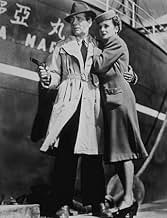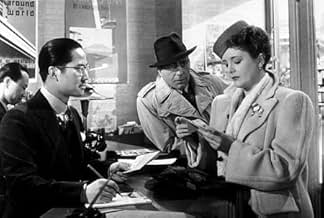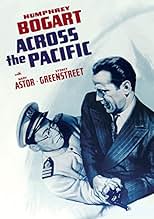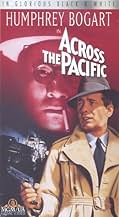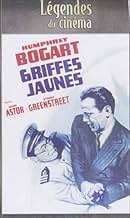IMDb-BEWERTUNG
6,8/10
5633
IHRE BEWERTUNG
Füge eine Handlung in deiner Sprache hinzuIn December 1941, ex-army captain Rick Leland boards a Japanese ship heading to Asia via the Panama Canal where his Japanese hosts show interest in the American defense plans for the canal z... Alles lesenIn December 1941, ex-army captain Rick Leland boards a Japanese ship heading to Asia via the Panama Canal where his Japanese hosts show interest in the American defense plans for the canal zone.In December 1941, ex-army captain Rick Leland boards a Japanese ship heading to Asia via the Panama Canal where his Japanese hosts show interest in the American defense plans for the canal zone.
- Regie
- Drehbuch
- Hauptbesetzung
- Auszeichnungen
- 1 Gewinn & 1 Nominierung insgesamt
Victor Sen Yung
- Joe Totsuiko
- (as Sen Young)
Lee Tong Foo
- Sam Wing On
- (as Lee Tung Foo)
Empfohlene Bewertungen
"Across the Pacific" is a fairly well done spy movie that takes place in the last days before America's entry into World War II. Rick Leland (Humphrey Bogart) is cashiered from the U.S. Army for stealing funds. The events that follow involve a love interest (Mary Astor) and an enemy agent (Sydney Greenstreet) and a trip on a passenger ship from New York to the Panama Canal. Humphrey Bogart as an American spy is convincing in a role that might have been played by Sean Connery 20 years later.
The subplot of a Japanese plot to torpedo the Panama Canal and put it out of action was a case of truth being stranger than fiction with the recent revelation of Japanese submarines which carried planes designed to knock the canal out, but which were never used. "Across the Pacific" has humor, action and romance and is one of Bogart's lesser known but very good movies.
The subplot of a Japanese plot to torpedo the Panama Canal and put it out of action was a case of truth being stranger than fiction with the recent revelation of Japanese submarines which carried planes designed to knock the canal out, but which were never used. "Across the Pacific" has humor, action and romance and is one of Bogart's lesser known but very good movies.
There are films that are so connected to their times, when taken out of context there's no rhyme, no reason for portrayals, but factor in the great betrayals, lets you accept the extremes, of paradigms. As Rick Leland is disgraced and then ejected, from a role that he would like to have perfected, leaves him in a tricky place, after losing all his face, and he's become quite disengaged and disaffected. On a boat he gets to meet curious souls, who have ambitions to dispose and take controls, as the layers are peeled back, looks like there might be an attack, by the folks who like to eat food out of bowls.
Of its time.
Of its time.
Richard Macaulay had to do some fast rewrites on this John Huston-directed picture, based upon a magazine serial by Robert Carson. When dishonorably discharged Army Officer Humphrey Bogart is revealed to be a spy staking out a powerful Japanese sympathizer aboard a vessel to the Orient, the portly commander was originally supposed to be supervising the bombing of Pearl Harbor. When that occurred in real-life while the picture was in production, Macaulay hurriedly switched the locale to the Panama Canal (making the film's title irrelevant). However, even if the story structure is patchy--and Mary Astor's role as a plantation owner's daughter ultimately doesn't make much sense--"Across the Pacific" has a dryly joshing quality about it, and the end results are pleasant if unremarkable. Bogart (playing 'Rick', sometimes 'Ricky') is in jovial spirits throughout, especially when comparing gun sizes with Sydney Greenstreet (never better) or fingering Astor's back after she's acquired a sunburn; his blithe, easy performance makes the film enjoyable. Astor (ostensibly the love-interest) doesn't pour on the charm in her scenes with Bogie; she plays it rather big-sisterly with him, a seen-it-all kind of gal, and this works extremely well. The finale is a sign of the times--American fighter planes fill the skies--but even this corny touch works a little magic, despite the film's misshapen quality and sluggish beginning. **1/2 from ****
This film contains many aspects of the noir, including the clipped bantering dialogue with the clever intent. Coming soon after The Maltese Falcon, Across the Pacific is something of a mystery movie too.
Rick Leland (Humphrey Bogart) is a disgraced military man with dubious loyalties. He gets on a Japanese ship that is sailing to New York City, the Canal Zone and the Orient. While onboard, he becomes familiar with the other passengers: a western businessman named Dr. Leland (Sydney Greenstreet) who has a penchant for all things oriental and a smalltown woman named Alberta (Mastor Astor) who is taking a pleasure cruise.
But we sense all is not as it seems. Will Rick sail off into the Japanese sunset, bitter at the country that snubbed him? Will the doctor reveal an insidious intent? Will Alberta prove to be more than a romantic foil for Rick?
The action takes place not long before the U.S. would be forced to enter the war. Tensions are high. Eventually there is gunplay and all motives are revealed. Along the way, ATP proves to be an interesting film. The ending reminded me of another film that would follow in 1959--North by Northwest. ATP is a high stakes game of cat and mouse that coexists with a lighthearted romance.
My one complaint is that Mary Astor is not an actress I think would inspire lust in Bogart's Rick. Someone like Rita Hayworth would better fit the bill.
Rick Leland (Humphrey Bogart) is a disgraced military man with dubious loyalties. He gets on a Japanese ship that is sailing to New York City, the Canal Zone and the Orient. While onboard, he becomes familiar with the other passengers: a western businessman named Dr. Leland (Sydney Greenstreet) who has a penchant for all things oriental and a smalltown woman named Alberta (Mastor Astor) who is taking a pleasure cruise.
But we sense all is not as it seems. Will Rick sail off into the Japanese sunset, bitter at the country that snubbed him? Will the doctor reveal an insidious intent? Will Alberta prove to be more than a romantic foil for Rick?
The action takes place not long before the U.S. would be forced to enter the war. Tensions are high. Eventually there is gunplay and all motives are revealed. Along the way, ATP proves to be an interesting film. The ending reminded me of another film that would follow in 1959--North by Northwest. ATP is a high stakes game of cat and mouse that coexists with a lighthearted romance.
My one complaint is that Mary Astor is not an actress I think would inspire lust in Bogart's Rick. Someone like Rita Hayworth would better fit the bill.
This serves as a nice companion piece to "The Maltese Falcon", but DON'T compare it the masterpiece or you won't enjoy it. Also, keep in mind, this was during the beginning of WWII (obviously), so expect your typical "all Japanese are evil" racial stereotypes. It is upsetting to see that films like these just heightened the US's paranoia, driving us to send everyone of Japanese descent to internment camps.
You're going to really enjoy this film if you've seen modern Pulp adventures like the Indiana Jones trilogy or Sky Captain (though don't expect to see ANY mystical/sci-fi elements involved). This has it all: a hard-boiled hero, exotic locales, constant plot twists and turns, colorful villains, and a mysterious woman.
Bogart, as (almost) always plays the same character he always plays. but boy, does he fit in SO well into this film. Mary Astor, while not the pretty face that she was built up to be here and in "The Maltese Falcon", gives another great performance, and unlike Bogart, she was always able to give characters in a similar vein (in this case, the mysterious woman), each their own personalities. Her Alberta Marlow is not at all like "schoolgirl" Brigid O'Shaughnessey, but (at least openly) tougher, a perfect match with Bogart during their exchanges of dialogue, while remaining to be extremely ambiguous, never making sure whether or not she's an ally or a femme fatale. When all is revealed, looking back on it things made perfect sense with her character's attitude.
Sydney Greenstreet adds another great villain to his own rogues gallery. Here he's a man obsessed with Japanese culture and way of life, so much that he has become apart of and accepted by "the enemy". Victor Sen Young, who played a great shark grinned scumbag in "The Letter", does good here, looking very happy that he at least was able to speak coherently for once in a motion picture.
Huston's direction is really worth looking at, especially visually stunning during a sequence at a movie theater. Without his obvious presence and Bogart, this film would have just been another propaganda story of espionage. Sadly, when he had to leave the film for war duty, the final scenes were shot by otherwise competent (but nothing special) director Vincent Sherman. The final 15 minutes seem extremely out of place with the rest of the film, and its a shame Huston wasn't around a little bit longer to round up what could have been a quintessential piece of a feature 40's pulp movie.
Worth seeing, its a film that falls short of greatness, but man is it entertaining.
You're going to really enjoy this film if you've seen modern Pulp adventures like the Indiana Jones trilogy or Sky Captain (though don't expect to see ANY mystical/sci-fi elements involved). This has it all: a hard-boiled hero, exotic locales, constant plot twists and turns, colorful villains, and a mysterious woman.
Bogart, as (almost) always plays the same character he always plays. but boy, does he fit in SO well into this film. Mary Astor, while not the pretty face that she was built up to be here and in "The Maltese Falcon", gives another great performance, and unlike Bogart, she was always able to give characters in a similar vein (in this case, the mysterious woman), each their own personalities. Her Alberta Marlow is not at all like "schoolgirl" Brigid O'Shaughnessey, but (at least openly) tougher, a perfect match with Bogart during their exchanges of dialogue, while remaining to be extremely ambiguous, never making sure whether or not she's an ally or a femme fatale. When all is revealed, looking back on it things made perfect sense with her character's attitude.
Sydney Greenstreet adds another great villain to his own rogues gallery. Here he's a man obsessed with Japanese culture and way of life, so much that he has become apart of and accepted by "the enemy". Victor Sen Young, who played a great shark grinned scumbag in "The Letter", does good here, looking very happy that he at least was able to speak coherently for once in a motion picture.
Huston's direction is really worth looking at, especially visually stunning during a sequence at a movie theater. Without his obvious presence and Bogart, this film would have just been another propaganda story of espionage. Sadly, when he had to leave the film for war duty, the final scenes were shot by otherwise competent (but nothing special) director Vincent Sherman. The final 15 minutes seem extremely out of place with the rest of the film, and its a shame Huston wasn't around a little bit longer to round up what could have been a quintessential piece of a feature 40's pulp movie.
Worth seeing, its a film that falls short of greatness, but man is it entertaining.
Wusstest du schon
- WissenswertesDirector Vincent Sherman met with John Huston just before Huston left the project to join the United States Army Signal Corps to shoot documentaries for the war effort.
The two directors conferred just before they were about to shoot the scene in which Leland is trapped in the movie theatre and three assassins are trying to kill him.
"How does he get out?" Sherman asked. Huston replied, "That's your problem! I'm off to the war!"
John Huston then went off to join the war effort before the film was finished, taking the film script with him, explaining "Bogie will know how to get out." The studio's solution to the problem was to discard Huston's footage of the impossible dilemma and write a new scenario. Vincent Sherman directed the final scenes.
- PatzerThe background for the opening titles is a map of the Panama Canal. The orientation of the map and the compass is correct, but the labeling of the map is incorrect. In fact, the Atlantic end of the canal and the city of Colon are at the upper left (Northwest), and the Pacific end of the canal and Panama City are at the lower right (Southeast). The map is correctly labeled behind the closing credits.
- Zitate
Rick Leland: [comparing his gun to Dr. Lorenz's, which he points at him] Remember: mine is bigger than yours!
- Crazy CreditsOpening Card:
Governor's Island
New York
- Alternative VersionenAlso available in a computer colorized version.
- VerbindungenFeatured in Frances Farmer Presents: Across the Pacific (1959)
Top-Auswahl
Melde dich zum Bewerten an und greife auf die Watchlist für personalisierte Empfehlungen zu.
- How long is Across the Pacific?Powered by Alexa
Details
- Erscheinungsdatum
- Herkunftsland
- Sprachen
- Auch bekannt als
- Across the Pacific
- Drehorte
- Produktionsfirma
- Weitere beteiligte Unternehmen bei IMDbPro anzeigen
- Laufzeit
- 1 Std. 37 Min.(97 min)
- Farbe
- Seitenverhältnis
- 1.37 : 1
Zu dieser Seite beitragen
Bearbeitung vorschlagen oder fehlenden Inhalt hinzufügen


